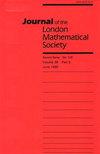Size-Ramsey numbers of graphs with maximum degree three
IF 1
2区 数学
Q1 MATHEMATICS
Journal of the London Mathematical Society-Second Series
Pub Date : 2025-03-11
DOI:10.1112/jlms.70116
引用次数: 0
Abstract
The size-Ramsey number of a graph is the smallest number of edges a (host) graph can have, such that for any red/blue colouring of , there is a monochromatic copy of in . Recently, Conlon, Nenadov and Trujić showed that if is a graph on vertices and maximum degree three, then , improving upon the upper bound of by Kohayakawa, Rödl, Schacht and Szemerédi. In this paper, we show that . While the previously used host graphs were vanilla binomial random graphs, we prove our result using a novel host graph construction. Our bound hits a natural barrier of the existing methods.

最大度为3的图的大小拉姆齐数
图H $H$的大小拉姆齐数r³(H) $\hat{r}(H)$是一个(主机)图的最小边数G $G$可以有,因此对于任何红色/蓝色的G $G$,在G $G$中都有一个单色的H $H$副本。最近,Conlon, Nenadov和trujiki证明,如果H $H$是一个有n $n$个顶点且最大次为3的图,那么r³(H) = 0 (n 8) /5) $\hat{r}(H) = O(n^{8/5})$;由Kohayakawa、Rödl、Schacht和szemersamudi改进了n 5 / 3 + o (1) $n^{5/3 + o(1)}$的上界。在本文中,我们证明了r³(H)≤n3 / 2 + 0(1) $\hat{r}(H)\leqslant n^{3/2+o(1)}$。虽然以前使用的主机图是普通的二项随机图,但我们使用一种新的主机图构造来证明我们的结果。我们的边界遇到了现有方法的自然障碍。
本文章由计算机程序翻译,如有差异,请以英文原文为准。
求助全文
约1分钟内获得全文
求助全文
来源期刊
CiteScore
1.90
自引率
0.00%
发文量
186
审稿时长
6-12 weeks
期刊介绍:
The Journal of the London Mathematical Society has been publishing leading research in a broad range of mathematical subject areas since 1926. The Journal welcomes papers on subjects of general interest that represent a significant advance in mathematical knowledge, as well as submissions that are deemed to stimulate new interest and research activity.

 求助内容:
求助内容: 应助结果提醒方式:
应助结果提醒方式:


